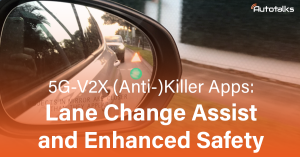By adding C-V2X to its existing 2nd generation automotive qualified chipset, Autotalks is paving the way to road safety everywhere
September 5th, Kfar Netter, Israel – Autotalks, global leader in V2X, announced the launch of the first ever global V2X solution. Autotalks’ deployment-ready, 2nd generation V2X (Vehicle to Everything) chipset is the only available solution capable of supporting both DSRC and C-V2X direct communications (PC5 protocol) at the highest security level. The chipset supports DSRC based on 802.11p/ITS-G5 standards and C-V2X based on 3GPP specifications.
V2X communication is heading to mass-market adoption as the world’s largest OEMs announced intentions to equip their new car models with the technology. In recent years, V2X diverged into two different technologies, DSRC and C-V2X, with fundamentally different architectures, making it difficult to harmonize a single global solution. Autotalks, a leader and innovator in V2X, addresses the need for a global solution by equipping its mass-market ready 2nd generation chipsets with C-V2X in addition to their native support of DSRC. Autotalks brings a decade of wireless expertise, which led to an industry leading radio performance. This solid foundation of modem and radio specifically built and optimized for V2X, coupled with the company’s deep knowledge of 3GPP standards and implementation, will result in superior C-V2X direct communications performance.
While DSRC-based V2X is deployed in the US, Europe and Japan, C-V2X is gaining momentum in other regions. Autotalks chipsets were designed from the ground up to meet V2X market requirements and standards, which gives its C-V2X offering a head start to meet security, environmental, quality, thermal and other requirements. Delivering dual-mode (DSRC and C-V2X) functionality on existing automotive qualified AEC-Q100 grade 2 chipsets while leveraging production grade software and maintaining the present API, enables the shortest time to market for a global dual-mode V2X platform. Autotalks solution minimizes development, testing and certification efforts for a V2X system to be deployed anywhere, via a software-defined toggle between V2X technologies.
Autotalks’ PC5 solution utilizes the globally defined 5.9 GHz ITS spectrum for V2X and is cellular network agnostic (no cellular SIM or coverage required, works without or with any 3G/4G/5G cellular modem). Separating V2X from the cellular Network Access Device (NAD) improves the cost-effectiveness of Telematic Control Unit (TCU) deployments. The separation of V2X from in-vehicle infotainment ensures that the purpose of the V2X system, which is giving drivers alerts of on-road dangers, is not compromised. Furthermore, V2X isolation combined with Autotalks’ recognized cybersecurity leadership, leads to a truly secure platform; a fundamental V2X requirement and necessity. To learn more about the separation of PC5 from cellular NAD, please read this whitepaper.
“Autotalks is proud to announce that its existing 2nd generation chipset can now support PC5,” said Hagai Zyss, CEO of Autotalks. “It is a revolutionary stride proving Autotalks’ market leadership. This demonstrates that a truly secure global V2X solution could have only been developed by a company that has multidisciplinary experience in creating Automotive safety communication solutions. We are committed to staying forward thinkers and bringing to mass-market a V2X solution that will save lives in all regions and protocols in the most cost-efficient manner.”
About Autotalks
Autotalks (www.auto-talks.com), which was founded in 2008, is a V2X chipset market pioneer and leader, providing customers with state-of-the-art V2X solutions. Autotalks helps reduce collisions on roadways and improve mobility with its automotive qualified chipsets. The chipsets offer the most advanced, truly secure and highest performing V2X communication solution designed for autonomous vehicles. Autotalks’ advanced technology, to be mass deployed in the coming years, complements the information coming from other sensors, specifically in non-line-of-sight scenarios, rough weather or poor lighting conditions. It significantly improves overall road safety, effectively coordinating vehicles, self-driving cars, motorcyclists and pedestrians.








